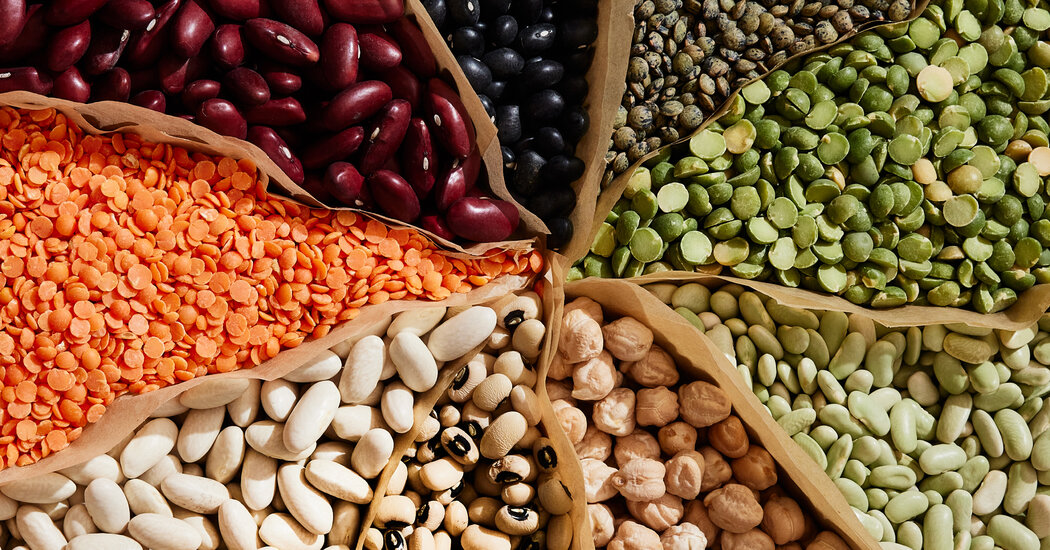This is Day 3 of Well’s Mediterranean Diet Week. Start at the beginning here.
If I had to choose just one food to always have on hand, it probably would be lentils. They’re quick to cook and comforting; my mom’s lentil soup was a staple of my childhood. But I’d also take any of the other legumes — chickpeas, black-eyed peas, cannellini beans, kidney beans.
Legumes are a key source of plant-based protein in the Mediterranean diet; one cup of cooked beans, lentils or peas contains about 15 grams of protein — just under a quarter of the daily needs of an average adult. And research suggests that people who get more of their protein from plant (rather than animal) sources tend to live longer, healthier lives.
One cup of legumes also contains about 13 grams of fiber, or roughly half of your daily recommended amount. Fiber helps keep your digestive system running smoothly, feeds friendly gut microbes and is thought to trap cholesterol in the intestines, which may explain the research suggesting that eating legumes can lower your levels of LDL (or “bad”) cholesterol. Researchers have also linked legumes to improved blood sugar levels and reduced risks of coronary heart disease.
Legumes supply several vitamins and minerals, including iron, which is necessary for oxygen delivery to cells; magnesium, which helps regulate blood pressure and blood sugar; folate, essential for pregnancy and cell function; and vitamin E, which supports the immune system and protects against cell damage.
Mediterranean diet guidelines typically suggest having at least two or three servings of legumes per week, which can be done without having to turn on your stove.
But it’s fun — and pretty darn easy — to cook with legumes, too. And our colleagues at NYT Cooking have a wealth of recipes for us to try.
What to keep on hand
Beans, lentils and peas are excellent pantry staples because they’re usually inexpensive and have a long shelf life. Throw in a few refrigerated and frozen items, and you’ll have a variety of legumes to choose from.
Here’s what is always on my shopping list:
-
Hummus for snacking and sandwiches (you can buy it premade or consider whipping it up yourself)
-
Canned beans for quick additions to soups, salads, nachos or tacos
-
Dried lentils and beans (if you’ve never cooked beans from scratch, start with our fantastic guide)
-
Frozen peas and edamame
How to cook with legumes
For each day of our Mediterranean diet series, we and our colleagues at NYT Cooking have selected a few recipes that incorporate the ingredients we’re highlighting. This is not intended to be a meal plan for a day, but rather inspiration for how to include more of these healthful foods in your week.
Beans for breakfast? Yes, please. Just add a scoop of black beans to your scrambled eggs and top with salsa, or you can get a little fancier with Kay Chun’s gorgeous huevos rancheros. If you’re planning ahead, try J.J. Goode’s adaptation of Steve Sando’s simple beans on toast; cook up a batch of dried beans on the weekend, and you’ve got breakfast covered for at least a few mornings of the week ahead.
For lunch, this chickpea salad sandwich, made with canned chickpeas mashed with a creamy lemon-tahini dressing, is delicious and easy to make in advance. Lidey Heuck’s quick cherry tomato and white bean salad, with a generous hunk of whole-grain bread dipped in olive oil, also makes for a light lunch.
Two of my favorite dinner recipes are Melissa Clark’s red lentil soup and Ali Slagle’s sheet-pan feta with chickpeas and tomatoes. They’re simple to prepare from ingredients you may already have on hand — and with a green salad and good bread, they make for satisfying meals.







